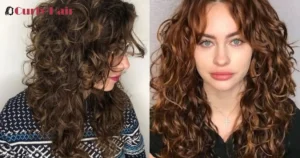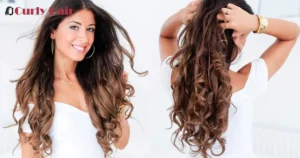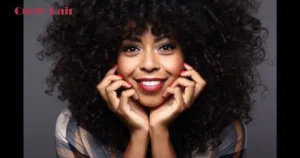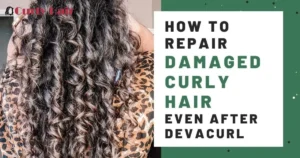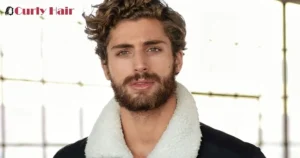Getting curly hair straight is a common struggle for many people. Curly hair has a different texture and structure than straight hair. The curls and bends in the hair strands make it resistant to straightening.
Why is my curly hair straight, is a question many curlies ask. Curly hair has a mind of its own one day bouncy, the next lifeless. The struggle to maintain those gorgeous ringlets is real. Humidity, products, and even sleep can impact curl formation.
Curly hair can be unpredictable – humidity, products, and even sleeping positions impact curl formation. One day you have beautiful ringlets, the next they’re flat and lifeless. But don’t fret! Understanding your hair’s needs is key. With the right techniques and gentle, moisture-rich products, you can revive those gorgeous curls.
Key Takeaways
- Genetic factors play a significant role in determining hair texture and curl pattern.
- Environmental influences, such as heat styling, can cause long-term damage, leading to curly hair appearing straight.
- Proper hair care, including hydration and gentle detangling, can help maintain natural curls.
- Consultation with a stylist can provide personalized advice for managing changes in curl structure.
- Embracing the uniqueness of one’s hair and understanding its needs is essential for achieving desired curliness.
Genetic Factors
| Genetic Factors | Description |
| Inherited Genes | Genes inherited from parents determine hair texture, thickness, and curl pattern. |
| Hair Follicle Shape | Variations in genes influence the shape of the hair follicle, dictating curliness. |
| Protein Production | Genes regulate the production of proteins like keratin, which affect hair structure and texture. |
| Family Traits | Familial tendencies towards certain hair characteristics are passed down through generations. |
| Genetic Predispositions | Unique genetic makeup influences the way hair looks and behaves, including its curliness. |
When it comes to understanding why your curly hair may appear straight, genetic factors play a pivotal role. Our genetic makeup, inherited from our parents, influences the texture, thickness, and curl pattern of our hair. Variations in genes responsible for the shape of the hair follicle determine whether hair grows straight, wavy, or curly.
Hormones
Within the realm of genetic factors influencing hair texture, hormones play a significant role. Hormonal changes, particularly during puberty, pregnancy, and menopause, can impact the shape and texture of hair follicles. Androgen hormones, such as testosterone, affect the size and activity of hair follicles, potentially altering curl patterns.
Chemotherapy
Chemotherapy, often used in cancer treatment, can cause temporary or permanent changes to hair follicles due to its effects on rapidly dividing cells.
While not directly related to inherited genetic factors, the impact of chemotherapy on hair is significant and can result in hair loss or changes in hair texture, including the temporary straightening of curly hair. Understanding these effects can provide insights into managing changes in hair appearance during cancer treatment.
A Change Of Climate
A climate change can significantly impact the appearance of your hair. When individuals with naturally curly hair move to regions with high humidity or frequent rainfall, their hair may appear straighter due to increased moisture levels. Conversely, in dry climates, curly hair may become frizzy or lose its defined curl pattern.
This change occurs because moisture affects the elasticity and shape of the hair shaft, altering its natural texture. Understanding how climate interacts with genetic predispositions can help you better manage and style your hair in different environments.
Genetics
Genetics intricately shape our hair’s texture and curl pattern, influenced by inherited genes from our parents. Variations in specific genes determine whether hair grows straight, wavy, or curly, elucidating why some individuals may have straight hair despite familial tendencies towards curls. Understanding these genetic predispositions provides valuable insights into the unique characteristics of our hair.
Impact Of Heat Styling
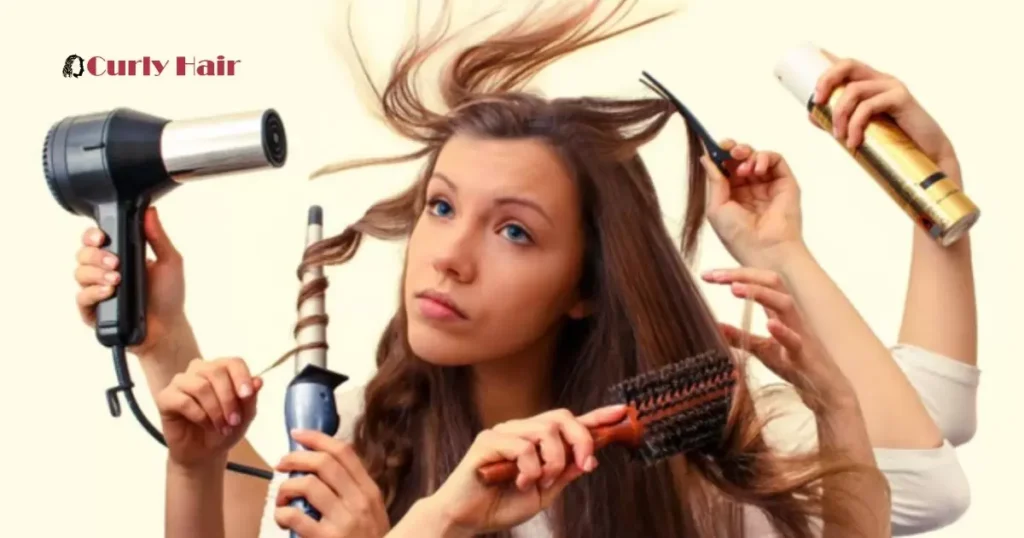
Excessive heat styling can significantly affect the natural hairitage good for curly hair texture. High temperatures from tools like straighteners or blow dryers can strip moisture from the hair, leaving it dry and prone to frizz. This can lead to a temporary straightening effect, altering the appearance of naturally curly hair.
Repeated use of heat styling tools can cause long-term damage to the hair shaft, resulting in permanent changes to its texture and curly hair going straight with age. Heat can weaken the protein structure of the hair, making it more susceptible to breakage and split ends. Over time, this can lead to a reduction in curl definition and resilience, causing curly hair to appear straighter than before.
Heat Styling Alternatives
Exploring alternatives to heat styling is essential for maintaining healthy, natural curls. Embrace air-drying methods, allowing your hair to dry naturally without the damaging effects of heat. Incorporate protective hairstyles like braids or twists to minimize manipulation and reduce the need for heat styling tools.
Experiment with heat-free styling techniques such as flexi-rods, twist-outs, or bantu knots to achieve defined curls without exposing your hair to excessive heat. Opt for products specifically formulated to enhance natural curls and provide moisture, reducing the reliance on heat styling for desired results. By incorporating these heat styling alternatives into your hair care routine, you can maintain the health and integrity of your curls while still achieving your desired look.
Hair Care Products
In our quest to understand why curly hair may sometimes appear straight, the role of hair care products is significant. The products we use can influence how our hair behaves and appears, impacting its texture and curl pattern. Certain shampoos, conditioners, and styling products contain ingredients that can weigh down curls or temporarily straighten hair, leading to a change in its natural appearance.
Choosing the right hair care products tailored to your hair type and desired outcome is essential for maintaining curly hair’s natural texture and preventing it from appearing straight. Look for products specifically formulated for curly hair, enriched with hydrating ingredients to enhance curl definition and minimize frizz.
Avoid products containing harsh chemicals or heavy silicones that can weigh down curls and inhibit their natural bounce. By selecting the appropriate hair care products, you can support and enhance your curls, ensuring they maintain their beautiful and distinct shape.
Hormonal Changes

Hormonal changes can significantly impact the appearance and behavior of our hair. Fluctuations in hormone levels, such as during puberty, pregnancy, or menopause, can alter hair texture and curl patterns. For instance, increased levels of androgens like testosterone can lead to coarser, thicker hair, while hormonal imbalances may cause hair to become frizzy or lose its natural curl.
Hormonal changes can affect the production of natural oils in the scalp, influencing hair health and texture. During puberty, for example, increased oil production may make hair appear greasier, while hormonal shifts during pregnancy can result in thicker, fuller hair due to decreased shedding. Understanding how hormones influence our hair can help us better manage and care for it during various life stages.
Environmental Factors
Environmental factors also play a significant role in altering the appearance of curly hair, contributing to occasional straightening. Exposure to heat, humidity, and sunlight can affect the hair’s moisture levels and structural integrity. High temperatures from styling tools, combined with humidity, can temporarily relax curls, making the hair appear straighter.
Environmental pollutants and chemicals in water can strip the hair of its natural oils, causing it to become weighed down and lose its curl. Sun exposure can also lead to damage and dryness, resulting in looser curls or even straightened hair over time. Understanding and mitigating these environmental influences can help maintain the natural curl pattern of the hair.
Health And Nutrition
In the realm of maintaining healthy hair, the role of proper nutrition cannot be overstated. A balanced diet rich in essential vitamins, minerals, and proteins is crucial for promoting hair health and growth. Nutrients like vitamin E, iron, and protein contribute to the strength and vitality of hair follicles, while deficiencies in these nutrients can lead to hair thinning and breakage.
Hydration plays a vital role in maintaining the moisture balance of the hair and scalp. Drinking an adequate amount of water daily helps to keep the scalp hydrated, preventing dryness and itchiness.
Hair Texture Evolution

As we delve into the intriguing realm of hair texture evolution, it becomes apparent that our hair’s characteristics have evolved in response to various environmental and genetic influences. Throughout human history, factors such as climate, diet, and natural selection have played significant roles in shaping the texture of our hair.
For instance, individuals living in humid regions may have developed curlier hair to better manage moisture, while those in colder climates might have straighter hair for insulation.
Curly Hair Maintenance Tips
Maintaining curly hair requires special care to keep it healthy and vibrant. Start with a gentle shampoo and conditioner specifically designed for curly hair to maintain moisture and enhance curls. Avoid brushing when dry to prevent frizz, instead, use a wide-tooth comb or fingers to detangle while wet, starting from the ends and working upwards.
Regular deep conditioning treatments can help nourish and define curls, reducing frizz and promoting shine. Consider using a leave-in conditioner or styling cream to add moisture and hold without weighing down your curls. Lastly, protect your curls overnight by sleeping on a silk or satin pillowcase to minimize friction and maintain your style for longer periods. With these simple tips, you can keep your curly hair looking its best every day.
Avoiding Harsh Ingredients
In the quest to maintain healthy, vibrant hair, avoiding harsh ingredients is paramount. Opt for hair care products free from sulfates, parabens, and silicones, as these chemicals can strip the hair of its natural oils, leading to dryness and damage. Instead, choose gentle, natural alternatives that nourish and protect your hair without causing harm.
Look for ingredients like coconut oil, shea butter, and argan oil, which provide hydration and promote hair strength and elasticity. Consider using sulfate-free shampoos and conditioners to cleanse your hair effectively without causing excessive dryness or irritation. By being mindful of the ingredients in your hair care products, you can maintain your hair’s health and vitality while avoiding unnecessary damage.
Tips To Get Those Curls Curling Again

Hydration: Use moisturizing shampoos and conditioners with ingredients like shea butter or coconut oil.
Avoid Heat Styling: Minimize the use of flat irons and blow dryers, opt for air drying or a low-heat diffuser.
Use Wide-Tooth Comb: Detangle gently while damp to prevent breakage and preserve the curl pattern.
Apply Styling Products: Use curl-enhancing products like mousse or gel, and scrunch upwards for volume.
Protective Sleeping: Sleep on satin or silk pillowcases, or wrap hair with a silk scarf or bonnet.
Regular Trims: Schedule trims every 6-8 weeks to remove split ends and maintain shape.
Frequently Asked Questions
Why is my naturally curly hair going straight?
Natural changes in hair texture can occur due to various factors such as hormonal shifts, ageing, or external influences like heat styling or chemical treatments.
Can curly hair turn straight permanently?
Yes, curly hair can become permanently straightened through chemical treatments such as keratin treatments or chemical relaxers administered by professionals.
Why is my curly hair straight all of a sudden?
Sudden changes in curl patterns can be due to factors like hormonal fluctuations, heat damage, or changes in hair care routines. Consulting a stylist can help diagnose the specific cause and provide tailored solutions.
Conclusion
In conclusion, understanding, Why is my curly hair straight, involves a multifaceted approach. Genetic factors play a significant role in determining hair texture and curl pattern. However, environmental influences and hair care practices can also impact how our curls behave.
By implementing tips to nourish and protect curls, individuals can work towards maintaining their natural curl pattern. Consulting with a stylist can offer personalized advice for those experiencing sudden changes in their curl structure. Ultimately, embracing the uniqueness of one’s hair and caring for it appropriately can help achieve the desired curliness.



